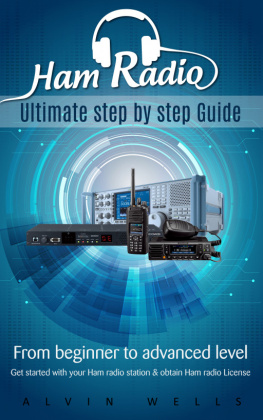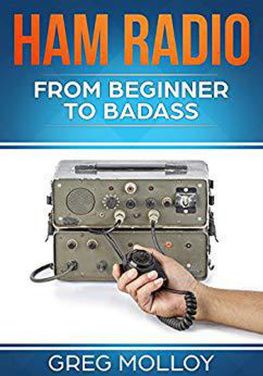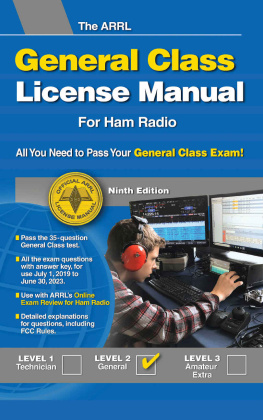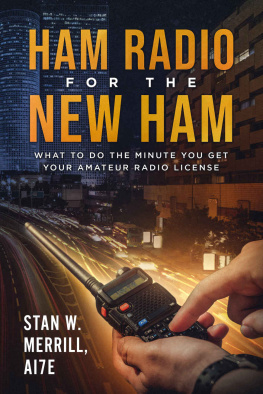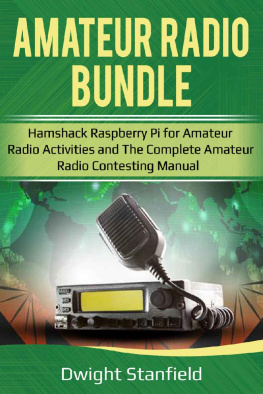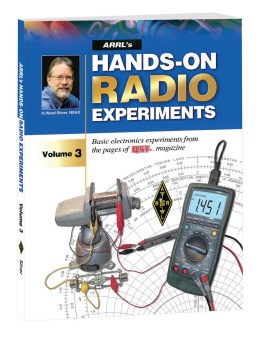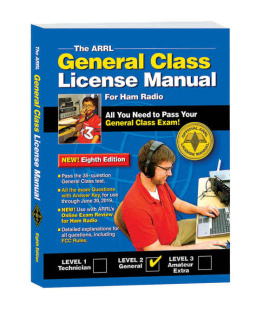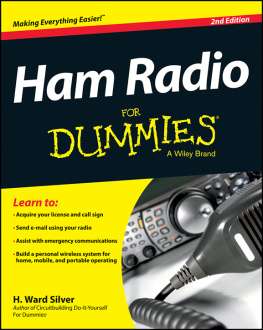Copyright 2014 by
The American Radio Relay League, Inc.
Copyright secured under the Pan-American Convention.
International Copyright secured.
All rights reserved. No part of this work may be reproduced in any form except by written permission of the publisher. All rights of translation are reserved.
Printed in USA
Quedan reservados todos los derechos
IBSN: 978-1-62595-017-8
Sixth Edition
First Printing
This book may be used for Technician license exams given beginning July 1, 2014. QST and the ARRL website (www.arrl.org) will have news about any rules changes affecting the Technician class license or any of the material in this book.
We strive to produce books without errors. Sometimes mistakes do occur, however. When we become aware of problems in our books (other than obvious typographical errors), we post corrections on the ARRL website. If you think you have found an error, please check .
eBooks created by www.ebookconversion.com

Technician Subelement T1
FCC Rules |
Technician Subelement T2
Operating Procedures |
Technician Subelement T3
Radio Waves, Propagation and Antennas |
Technician Subelement T4
Station Setup and Operation |
Technician Subelement T5
Electrical and Electronic Principles |
Technician Subelement T6
Electrical Components and Functions |
Technician Subelement T7
Station Equipment |
Technician Subelement T8
Operating Modes and Special Operations |
Technician Subelement T9
Antennas and Feed Lines |
Technician Subelement T0
Electrical and RF Safety |
Your Invitation to ARRL Membership

Congratulations on beginning your journey to join the diverse group of individuals who make up Amateur Radio! Its a big family there are more than 700,000 amateurs or hams in the United States and more than 3,000,000 around the world. This group is made up from a wide variety of people of all ages and walks of life, all around the world. These people use Amateur Radio to communicate directly, for the most part without relying on any commercial or government systems.
Your interest in ham radio may come from a desire to provide public service to your community, which can range from disaster response to monitoring severe weather to helping with parades or charity events. Perhaps you are one of the growing do it yourself community and are interested in learning more about electronics and wireless communication. Or you may have scientific interests that involve radio and similar natural phenomena. And maybe you like the idea of Amateur Radio providing an enjoyable hobby and a means of staying in touch with family and friends independent of the Internet or telephone networks. All are welcome and all are important to Amateur Radios future.
Recognizing that answering the exam questions correctly is only the beginning, be sure to take advantage of the additional material provided by the ARRL to help you get your license and then learn how to communicate as an amateur operator. The following Introduction section will present the ARRLs website and other online resources to help you. This is a key element of the ARRLs mission to help amateurs our motto is Of, By, and For the Amateur. By providing these resources, you will be better prepared to get on the air, have more fun, and be more effective on the air.
Most of the active amateur operators in the United States are ARRL members because they recognize the value of having an active national organization to represent them, provide training and educational opportunities, sponsor activities, and distribute information about the Amateur service. By joining, you support all of these and more. This book is just one of the ARRLs many publications for all levels and interests in Amateur Radio. You dont need a license to join the ARRL just be interested in Amateur Radio and the ARRL will be interested in you. Its that simple! Welcome to Amateur Radio.
David Sumner, K1ZZ
Chief Executive Officer
Newington, Connecticut
March 2014

A Question Pool Committee (QPC) consisting of representatives from the various Volunteer Examiner Coordinators (VECs) prepares the license question pools. The QPC establishes a schedule for revising and implementing new Question Pools. The current Question Pool revision schedule is as follows:
Question Pool | Current Study Guides | Valid Through |
Technician | The ARRL Ham Radio | June 30, 2018 |
(Element 2) | License Manual, 3rd Edition
ARRLs Tech Q&A, 6th Edition |
General | The ARRL General Class | June 30, 2015 |
(Element 3) | License Manual, 7th edition
ARRLs General Q&A, 4th Edition |
Amateur Extra | The ARRL Extra Class | June 30, 2016 |
(Element 4) | License Manual, 10th Edition
ARRLs Extra Q&A, 3rd Edition |
As new Question Pools are released, ARRL will produce new study materials before the effective date of the new pools. Until then, the current Question Pools will remain in use, and current ARRL study materials, including this book, will help you prepare for your exam.
As the new Question Pool schedules are confirmed, the information will be published in QST and on the ARRL website at www.arrl.org.

Use this book with ARRL Exam Review for Ham Radio to take randomly-generated practice exams using questions from the actual examination question pool. You wont have any surprises on exam day Go to www.arrl.org/examreview

The Technician License
Earning a Technician Amateur Radio license begins your enjoyment of ham radio. Topics covered by the exam provide you with a good introduction to basic radio requiring only modest math skills. You are sure to find the operating privileges available to a Technician licensee to be worth the time spent learning about Amateur Radio. After passing the exam, you will be able to operate on every frequency above 50 megahertz available to the Amateur service. You also gain privileges on the traditional shortwave 80, 40, 15 and 10 meter amateur bands. With this broad set of operating privileges, youll be ready to experience the excitement of Amateur Radio!
Perhaps your interest is in Amateur Radios long history of public service, such as providing emergency communications in time of need. You might have experience with computer networks leading you to explore the digital mode technology used in ham radio. If your eyes turn to the stars on a clear night, you might enjoy tracking the amateur satellites and using them to relay your signals to other amateurs around the world! Your whole family can enjoy Amateur Radio, taking part in outdoor activities such as ARRL Field Day and mobile operating during a vacation or weekend drive.


